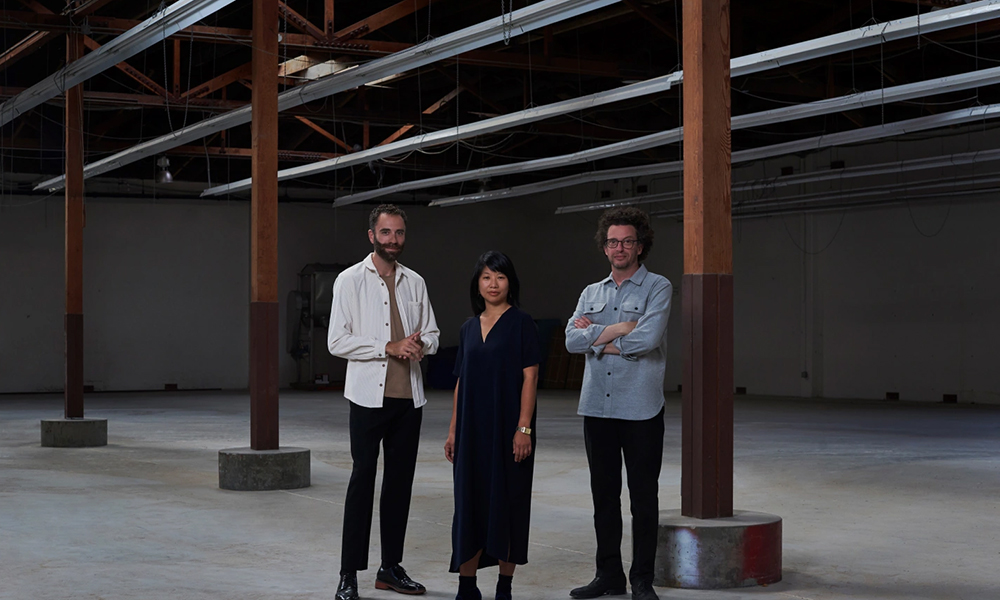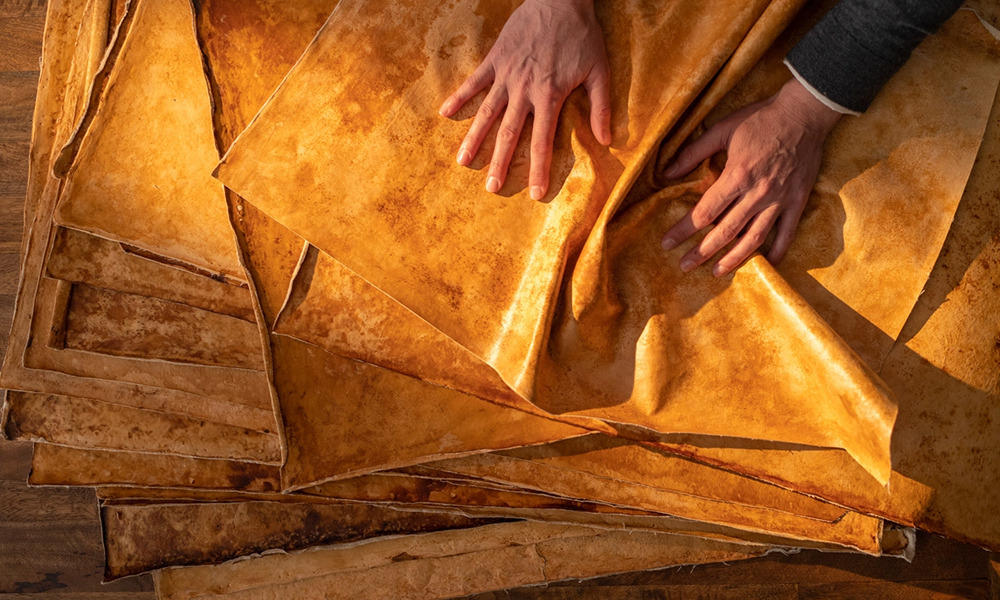
菲爾·羅斯剛開始一頭鉆進(jìn)蘑菇的世界里時(shí),,并沒有想過要發(fā)明一種新的服裝材料,,但現(xiàn)在,他和他人共同創(chuàng)造的真菌“皮革”已經(jīng)用于制作愛馬仕(Hermès)的奢侈品手袋了,,并且在不久的將來還將用作通用汽車(GM)的電動(dòng)汽車的內(nèi)飾,。
“對(duì)未來的塑造才剛剛開始。這個(gè)行業(yè)將繼續(xù)給人們驚喜,?!绷_斯說。
20世紀(jì)80年代末到90年代初,,羅斯在美國(guó)舊金山的藝術(shù)學(xué)校進(jìn)修時(shí)知道了靈芝的存在,,根據(jù)中醫(yī)的說法,靈芝有助于提升人體免疫力,。當(dāng)時(shí)羅斯在臨終關(guān)懷中心為癌癥和艾滋?。ˋIDS)的患者提供服務(wù)來維持生計(jì),于是開始在家里為病人們種植靈芝,。在近距離觀察中,,他注意到,靈芝絲狀的根(即菌絲體)的可塑性很高,,能夠賦予其多種多樣的顏色,、形狀、密度和質(zhì)地——既可以像織物,,也能夠是像磚頭一樣的立體結(jié)構(gòu),。羅斯成為了菌絲體藝術(shù)家——而且相當(dāng)成功,他曾經(jīng)在紐約現(xiàn)代藝術(shù)博物館(MoMA),、杜塞爾多夫美術(shù)館(Kunsthalle Düsseldorf)和莫斯科雙年展(Moscow Biennale)上展出他的菌絲體作品,。
“事實(shí)上,菌絲體正是這樣向世界展示了它是一種有趣的功能性設(shè)計(jì)材料,?!痹?shī)歌博士索菲婭·王說,。索菲婭于2007年與羅斯相遇,之后兩人合作了一些藝術(shù)項(xiàng)目,。六年后,,兩人聯(lián)合創(chuàng)立了MycoWorks,發(fā)明生產(chǎn)菌絲體材料,。
發(fā)現(xiàn)菌絲體的可塑性是邁向突破的一步,。第二步發(fā)生在2016年,那一年,,羅斯和王從制造菌絲體塊(質(zhì)量輕,、天然防火,但作為商品則需要大規(guī)模生產(chǎn))轉(zhuǎn)向了制造類似皮革的柔性菌絲體材料,。羅斯和王意識(shí)到,,菌絲體“皮革”可以吸引那些因?yàn)樘烊黄じ锸褂脛?dòng)物制品且?guī)в谢瘜W(xué)污染物而對(duì)此止步的消費(fèi)者。

如今,,MycoWorks已經(jīng)籌集了超過1.87億美元的風(fēng)險(xiǎn)投資——投資者包括娜塔莉·波特曼和約翰·傳奇,,他們?cè)诿绹?guó)南卡羅來納州的工廠也已經(jīng)開工,每年生產(chǎn)數(shù)百萬(wàn)平方英尺的靈芝精細(xì)菌絲體仿皮革材料,。愛馬仕是該公司高級(jí)時(shí)尚行業(yè)的客戶,,今年10月,MycoWorks還宣布收到通用汽車(General Motors)旗下通用風(fēng)險(xiǎn)投資公司(GM Ventures)未明確項(xiàng)目的投資,,用于生產(chǎn)“可持續(xù)汽車材料”,,用作汽車內(nèi)飾等。MycoWorks拒絕提供該公司的估值或營(yíng)收,,公司約有200名員工,。
2017年加入公司擔(dān)任首席執(zhí)行官的材料科學(xué)博士馬特·斯卡林說:“當(dāng)前,越來越多的人希望購(gòu)買來源明確,、可追溯,、碳足跡更低、用水量更低的可持續(xù)產(chǎn)品,,品牌們都在做出重大調(diào)整以滿足上述需求,,而這些要求菌絲體全部能夠做到?!?/p>
皮革廠與石油
動(dòng)物皮革是一個(gè)骯臟的行業(yè),。麻省理工學(xué)院(MIT)的材料系統(tǒng)實(shí)驗(yàn)室(Materials Systems Lab)的一項(xiàng)研究顯示,皮革每年向地球排放約1.3億噸二氧化碳,,相當(dāng)于3,000萬(wàn)輛汽車,。
由于消費(fèi)者對(duì)環(huán)境和動(dòng)物權(quán)益的擔(dān)憂加劇,過去十年,,資金大量涌入生物材料領(lǐng)域,。
位于美國(guó)加州納帕的材料創(chuàng)新倡議(Materials Innovation Initiative)在其2021年對(duì)“下一代”材料行業(yè)(包括從植物、微生物,、回收利用物和人工培育的動(dòng)物細(xì)胞中提取的材料)的研究中發(fā)現(xiàn):2015年以來,,對(duì)該行業(yè)的投資已經(jīng)高達(dá)23億美元,其中2021年為9.8億美元,,是2020年的兩倍,;全球40個(gè)頂級(jí)時(shí)尚品牌中已經(jīng)有38個(gè)在積極搜尋下一代材料。
“很多投資者都對(duì)合成生物學(xué)頗感興趣,。菌絲體就是其中之一,。”材料創(chuàng)新倡議的首席創(chuàng)新官伊萊恩·西烏說:“投資者之所以感興趣,,是因?yàn)檫@個(gè)領(lǐng)域存在大量高價(jià)值知識(shí)產(chǎn)權(quán),。生物學(xué)真正代表了下一個(gè)階段:革命?!?/p>
西烏稱,,下一代材料的發(fā)展比植物肉產(chǎn)業(yè)滯后了大約五年。進(jìn)度緩慢的其中一個(gè)原因是很難得到大自然母親的配合:“生物學(xué)需要時(shí)間,?!彼f。
在黑暗中生長(zhǎng)
羅斯和王花了幾年時(shí)間才弄清楚種植蘑菇皮的最佳方式,。在這個(gè)過程中,,幾英寸深的托盤里裝滿了木屑、營(yíng)養(yǎng)物質(zhì)和水,,浸漬了真菌菌種,。真菌吞噬基質(zhì),在黑暗,、控溫的托盤中生長(zhǎng),,托盤尺寸為2乘3英尺,這是半塊牛皮的行業(yè)標(biāo)準(zhǔn),。真菌包裹在基質(zhì)上,,在基質(zhì)上長(zhǎng)出一塊質(zhì)地堅(jiān)實(shí)又輕盈的面板,這是一層白色的菌絲體——也就是皮革,。幾周后,,菌絲體最終可以像杏仁糖蛋糕上的糖霜一樣剝離。王解釋道:“從某種意義上說,,之所以會(huì)長(zhǎng)出這一層,,是為了保護(hù)它們的食物來源?!?/p>

在“皮革”生長(zhǎng)之前,,能夠在托盤中放入一層編織或合成材料,,甚至可以放入防彈的凱夫拉纖維,菌絲體能夠穿透這層材料生長(zhǎng),,增加強(qiáng)度或紋理,。最后,再對(duì)菌絲體片進(jìn)行鞣制和染色,。
斯卡林說,,該公司在美國(guó)加州埃默里維爾的試點(diǎn)生產(chǎn)線上已經(jīng)種植了“數(shù)以萬(wàn)計(jì)的”托盤。
商品
菌絲體皮革仍然比動(dòng)物皮革貴,。MycoWorks拒絕透露價(jià)格,,但其競(jìng)爭(zhēng)對(duì)手Bolt Threads告訴彭博社(Bloomberg),該公司的產(chǎn)品約為每平方英尺25美元,,與質(zhì)量上乘的小牛皮價(jià)格類似,,所以第一批使用這種材料的產(chǎn)品來自奢侈品界。
愛馬仕在法國(guó)的皮革工匠將MycoWorks的精細(xì)菌絲體轉(zhuǎn)變成一種琥珀色材料,,將其命名為“西爾瓦尼亞”(Sylvania),。愛馬仕用這種材料制作了“維多利亞”(Victoria)包的真菌版,價(jià)值4,200美元,,預(yù)計(jì)將在未來幾個(gè)月交付,。愛馬仕表示,三年的合作“將制作高品質(zhì)材料的專業(yè)技能與生物技術(shù)工具相結(jié)合”,。斯特拉·麥卡特尼使用其競(jìng)爭(zhēng)對(duì)手Bolt Threads的菌絲體材料制作了100個(gè)價(jià)值3,500美元的限量版Frayme Mylo單肩包,。(斯卡林說,MycoWorks和友商的區(qū)別在于,,MycoWorks種植的是一整塊菌絲,,其他公司則是用聚氨酯將一片片菌絲粘合起來。)
美國(guó)加州威尼斯的帽子制造商N(yùn)ick Fouquet是第一家銷售菌絲體帽子的品牌,,今年7月上市,,售價(jià)700美元一頂,共40頂,。他說,,成品和皮革非常相似,連公司的女裁縫都看不出其中區(qū)別,。唯一的不同在于氣味,,它散發(fā)的是“泥土氣息”。(MycoWorks現(xiàn)在的鞣制工藝已經(jīng)可以讓蘑菇皮擁有皮革的氣味,,但供給Fouquet的第一批材料還未使用,。)
通用汽車對(duì)MycoWorks的投資,旨在實(shí)現(xiàn)電動(dòng)汽車內(nèi)飾與發(fā)動(dòng)機(jī)同樣環(huán)保,。對(duì)汽車制造商而言,,這種材料還有其他優(yōu)勢(shì),。王說:“汽車行業(yè)對(duì)我們的材料感興趣的原因之一是,它能夠薄達(dá)0.2毫米,,是皮革厚度的一半,。所以在重量和可塑性上都更有優(yōu)勢(shì)?!?/p>
當(dāng)然,菌絲體皮革的發(fā)展仍然處于初級(jí)階段,,它能否像GoreTex一樣取得巨大成功仍然是未知數(shù),。市場(chǎng)研究公司似乎沒有就該行業(yè)的前景達(dá)成共識(shí)。北極星市場(chǎng)研究公司(Polaris Market Research)認(rèn)為,,“生物基皮革”市場(chǎng)將從2021年的6.47億美元增長(zhǎng)到2030年的11億美元,,年增長(zhǎng)率為6.2%。英菲尼姆全球研究公司(Infinium Global Research)預(yù)測(cè),,該市場(chǎng)將從2020年的2.36億美元增長(zhǎng)到2027年的35億美元,,年增長(zhǎng)率為47%。
斯卡林相信,,隨著價(jià)格下降和產(chǎn)量提升,,菌絲體皮革可以取代市場(chǎng)上現(xiàn)有的大部分材料——不僅僅是牛皮。
“業(yè)界想要的是一種能夠讓它們打入一個(gè)不斷增長(zhǎng)的新興市場(chǎng)的材料,,滿足消費(fèi)者對(duì)可持續(xù)材料和品質(zhì)更高的材料的需求,。它們不是在尋找皮革的替代品?!彼f,。相反,由于其溫暖,、“有活力”的質(zhì)地,,菌絲體皮革將成為一種新選擇,可以輕松取代當(dāng)前占據(jù)皮革市場(chǎng)一半以上份額的“聚氨酯合成革”,。
其他人則想要更進(jìn)一步,,回到MycoWorks的初始產(chǎn)品。麻省理工學(xué)院的比特與原子研究中心(Center for Bits and Atoms)的研究科學(xué)家安德烈亞斯·梅爾申和建筑師克里斯·毛雷爾正在主持一個(gè)項(xiàng)目,,用牡蠣蘑菇菌絲體制成的磚塊在納米比亞建造房屋,。
“想想看,不再需要運(yùn)輸任何建筑材料,。只需要運(yùn)輸孢子,,然后在當(dāng)?shù)卣胰我猬F(xiàn)成的材料進(jìn)行接種。你就能夠在現(xiàn)場(chǎng)種植建筑材料了,?!绷_德島設(shè)計(jì)學(xué)院自然實(shí)驗(yàn)室(RISD Nature Lab)的臨時(shí)主任詹妮弗·比索內(nèi)特說:“它在生產(chǎn)住房和食物來源,。想想這些微生物可以滿足人類的各種基本需求,簡(jiǎn)直不可思議,?!保ㄘ?cái)富中文網(wǎng))
譯者:Agatha
菲爾·羅斯剛開始一頭鉆進(jìn)蘑菇的世界里時(shí),并沒有想過要發(fā)明一種新的服裝材料,,但現(xiàn)在,,他和他人共同創(chuàng)造的真菌“皮革”已經(jīng)用于制作愛馬仕(Hermès)的奢侈品手袋了,并且在不久的將來還將用作通用汽車(GM)的電動(dòng)汽車的內(nèi)飾,。
“對(duì)未來的塑造才剛剛開始,。這個(gè)行業(yè)將繼續(xù)給人們驚喜?!绷_斯說,。
20世紀(jì)80年代末到90年代初,羅斯在美國(guó)舊金山的藝術(shù)學(xué)校進(jìn)修時(shí)知道了靈芝的存在,,根據(jù)中醫(yī)的說法,,靈芝有助于提升人體免疫力。當(dāng)時(shí)羅斯在臨終關(guān)懷中心為癌癥和艾滋?。ˋIDS)的患者提供服務(wù)來維持生計(jì),,于是開始在家里為病人們種植靈芝。在近距離觀察中,,他注意到,,靈芝絲狀的根(即菌絲體)的可塑性很高,能夠賦予其多種多樣的顏色,、形狀,、密度和質(zhì)地——既可以像織物,也能夠是像磚頭一樣的立體結(jié)構(gòu),。羅斯成為了菌絲體藝術(shù)家——而且相當(dāng)成功,,他曾經(jīng)在紐約現(xiàn)代藝術(shù)博物館(MoMA)、杜塞爾多夫美術(shù)館(Kunsthalle Düsseldorf)和莫斯科雙年展(Moscow Biennale)上展出他的菌絲體作品,。
“事實(shí)上,,菌絲體正是這樣向世界展示了它是一種有趣的功能性設(shè)計(jì)材料?!痹?shī)歌博士索菲婭·王說,。索菲婭于2007年與羅斯相遇,之后兩人合作了一些藝術(shù)項(xiàng)目,。六年后,,兩人聯(lián)合創(chuàng)立了MycoWorks,發(fā)明生產(chǎn)菌絲體材料。
發(fā)現(xiàn)菌絲體的可塑性是邁向突破的一步,。第二步發(fā)生在2016年,,那一年,羅斯和王從制造菌絲體塊(質(zhì)量輕,、天然防火,,但作為商品則需要大規(guī)模生產(chǎn))轉(zhuǎn)向了制造類似皮革的柔性菌絲體材料。羅斯和王意識(shí)到,,菌絲體“皮革”可以吸引那些因?yàn)樘烊黄じ锸褂脛?dòng)物制品且?guī)в谢瘜W(xué)污染物而對(duì)此止步的消費(fèi)者,。
如今,MycoWorks已經(jīng)籌集了超過1.87億美元的風(fēng)險(xiǎn)投資——投資者包括娜塔莉·波特曼和約翰·傳奇,,他們?cè)诿绹?guó)南卡羅來納州的工廠也已經(jīng)開工,,每年生產(chǎn)數(shù)百萬(wàn)平方英尺的靈芝精細(xì)菌絲體仿皮革材料。愛馬仕是該公司高級(jí)時(shí)尚行業(yè)的客戶,,今年10月,,MycoWorks還宣布收到通用汽車(General Motors)旗下通用風(fēng)險(xiǎn)投資公司(GM Ventures)未明確項(xiàng)目的投資,,用于生產(chǎn)“可持續(xù)汽車材料”,,用作汽車內(nèi)飾等。MycoWorks拒絕提供該公司的估值或營(yíng)收,,公司約有200名員工,。
2017年加入公司擔(dān)任首席執(zhí)行官的材料科學(xué)博士馬特·斯卡林說:“當(dāng)前,越來越多的人希望購(gòu)買來源明確,、可追溯,、碳足跡更低、用水量更低的可持續(xù)產(chǎn)品,,品牌們都在做出重大調(diào)整以滿足上述需求,,而這些要求菌絲體全部能夠做到?!?/p>
皮革廠與石油
動(dòng)物皮革是一個(gè)骯臟的行業(yè),。麻省理工學(xué)院(MIT)的材料系統(tǒng)實(shí)驗(yàn)室(Materials Systems Lab)的一項(xiàng)研究顯示,皮革每年向地球排放約1.3億噸二氧化碳,,相當(dāng)于3,000萬(wàn)輛汽車,。
由于消費(fèi)者對(duì)環(huán)境和動(dòng)物權(quán)益的擔(dān)憂加劇,過去十年,,資金大量涌入生物材料領(lǐng)域,。
位于美國(guó)加州納帕的材料創(chuàng)新倡議(Materials Innovation Initiative)在其2021年對(duì)“下一代”材料行業(yè)(包括從植物、微生物,、回收利用物和人工培育的動(dòng)物細(xì)胞中提取的材料)的研究中發(fā)現(xiàn):2015年以來,,對(duì)該行業(yè)的投資已經(jīng)高達(dá)23億美元,其中2021年為9.8億美元,是2020年的兩倍,;全球40個(gè)頂級(jí)時(shí)尚品牌中已經(jīng)有38個(gè)在積極搜尋下一代材料,。
“很多投資者都對(duì)合成生物學(xué)頗感興趣。菌絲體就是其中之一,?!辈牧蟿?chuàng)新倡議的首席創(chuàng)新官伊萊恩·西烏說:“投資者之所以感興趣,是因?yàn)檫@個(gè)領(lǐng)域存在大量高價(jià)值知識(shí)產(chǎn)權(quán),。生物學(xué)真正代表了下一個(gè)階段:革命,。”
西烏稱,,下一代材料的發(fā)展比植物肉產(chǎn)業(yè)滯后了大約五年,。進(jìn)度緩慢的其中一個(gè)原因是很難得到大自然母親的配合:“生物學(xué)需要時(shí)間?!彼f,。
在黑暗中生長(zhǎng)
羅斯和王花了幾年時(shí)間才弄清楚種植蘑菇皮的最佳方式。在這個(gè)過程中,,幾英寸深的托盤里裝滿了木屑,、營(yíng)養(yǎng)物質(zhì)和水,浸漬了真菌菌種,。真菌吞噬基質(zhì),,在黑暗、控溫的托盤中生長(zhǎng),,托盤尺寸為2乘3英尺,,這是半塊牛皮的行業(yè)標(biāo)準(zhǔn)。真菌包裹在基質(zhì)上,,在基質(zhì)上長(zhǎng)出一塊質(zhì)地堅(jiān)實(shí)又輕盈的面板,,這是一層白色的菌絲體——也就是皮革。幾周后,,菌絲體最終可以像杏仁糖蛋糕上的糖霜一樣剝離,。王解釋道:“從某種意義上說,之所以會(huì)長(zhǎng)出這一層,,是為了保護(hù)它們的食物來源,。”
在“皮革”生長(zhǎng)之前,,能夠在托盤中放入一層編織或合成材料,,甚至可以放入防彈的凱夫拉纖維,菌絲體能夠穿透這層材料生長(zhǎng),,增加強(qiáng)度或紋理,。最后,,再對(duì)菌絲體片進(jìn)行鞣制和染色。
斯卡林說,,該公司在美國(guó)加州埃默里維爾的試點(diǎn)生產(chǎn)線上已經(jīng)種植了“數(shù)以萬(wàn)計(jì)的”托盤,。
商品
菌絲體皮革仍然比動(dòng)物皮革貴。MycoWorks拒絕透露價(jià)格,,但其競(jìng)爭(zhēng)對(duì)手Bolt Threads告訴彭博社(Bloomberg),,該公司的產(chǎn)品約為每平方英尺25美元,與質(zhì)量上乘的小牛皮價(jià)格類似,,所以第一批使用這種材料的產(chǎn)品來自奢侈品界,。
愛馬仕在法國(guó)的皮革工匠將MycoWorks的精細(xì)菌絲體轉(zhuǎn)變成一種琥珀色材料,將其命名為“西爾瓦尼亞”(Sylvania),。愛馬仕用這種材料制作了“維多利亞”(Victoria)包的真菌版,,價(jià)值4,200美元,預(yù)計(jì)將在未來幾個(gè)月交付,。愛馬仕表示,,三年的合作“將制作高品質(zhì)材料的專業(yè)技能與生物技術(shù)工具相結(jié)合”。斯特拉·麥卡特尼使用其競(jìng)爭(zhēng)對(duì)手Bolt Threads的菌絲體材料制作了100個(gè)價(jià)值3,500美元的限量版Frayme Mylo單肩包,。(斯卡林說,,MycoWorks和友商的區(qū)別在于,MycoWorks種植的是一整塊菌絲,,其他公司則是用聚氨酯將一片片菌絲粘合起來,。)
美國(guó)加州威尼斯的帽子制造商N(yùn)ick Fouquet是第一家銷售菌絲體帽子的品牌,,今年7月上市,,售價(jià)700美元一頂,共40頂,。他說,,成品和皮革非常相似,連公司的女裁縫都看不出其中區(qū)別,。唯一的不同在于氣味,,它散發(fā)的是“泥土氣息”。(MycoWorks現(xiàn)在的鞣制工藝已經(jīng)可以讓蘑菇皮擁有皮革的氣味,,但供給Fouquet的第一批材料還未使用,。)
通用汽車對(duì)MycoWorks的投資,旨在實(shí)現(xiàn)電動(dòng)汽車內(nèi)飾與發(fā)動(dòng)機(jī)同樣環(huán)保,。對(duì)汽車制造商而言,,這種材料還有其他優(yōu)勢(shì)。王說:“汽車行業(yè)對(duì)我們的材料感興趣的原因之一是,,它能夠薄達(dá)0.2毫米,,是皮革厚度的一半。所以在重量和可塑性上都更有優(yōu)勢(shì)?!?/p>
當(dāng)然,,菌絲體皮革的發(fā)展仍然處于初級(jí)階段,它能否像GoreTex一樣取得巨大成功仍然是未知數(shù),。市場(chǎng)研究公司似乎沒有就該行業(yè)的前景達(dá)成共識(shí),。北極星市場(chǎng)研究公司(Polaris Market Research)認(rèn)為,“生物基皮革”市場(chǎng)將從2021年的6.47億美元增長(zhǎng)到2030年的11億美元,,年增長(zhǎng)率為6.2%,。英菲尼姆全球研究公司(Infinium Global Research)預(yù)測(cè),該市場(chǎng)將從2020年的2.36億美元增長(zhǎng)到2027年的35億美元,,年增長(zhǎng)率為47%,。
斯卡林相信,隨著價(jià)格下降和產(chǎn)量提升,,菌絲體皮革可以取代市場(chǎng)上現(xiàn)有的大部分材料——不僅僅是牛皮,。
“業(yè)界想要的是一種能夠讓它們打入一個(gè)不斷增長(zhǎng)的新興市場(chǎng)的材料,滿足消費(fèi)者對(duì)可持續(xù)材料和品質(zhì)更高的材料的需求,。它們不是在尋找皮革的替代品,。”他說,。相反,,由于其溫暖、“有活力”的質(zhì)地,,菌絲體皮革將成為一種新選擇,,可以輕松取代當(dāng)前占據(jù)皮革市場(chǎng)一半以上份額的“聚氨酯合成革”。
其他人則想要更進(jìn)一步,,回到MycoWorks的初始產(chǎn)品,。麻省理工學(xué)院的比特與原子研究中心(Center for Bits and Atoms)的研究科學(xué)家安德烈亞斯·梅爾申和建筑師克里斯·毛雷爾正在主持一個(gè)項(xiàng)目,用牡蠣蘑菇菌絲體制成的磚塊在納米比亞建造房屋,。
“想想看,,不再需要運(yùn)輸任何建筑材料。只需要運(yùn)輸孢子,,然后在當(dāng)?shù)卣胰我猬F(xiàn)成的材料進(jìn)行接種,。你就能夠在現(xiàn)場(chǎng)種植建筑材料了?!绷_德島設(shè)計(jì)學(xué)院自然實(shí)驗(yàn)室(RISD Nature Lab)的臨時(shí)主任詹妮弗·比索內(nèi)特說:“它在生產(chǎn)住房和食物來源,。想想這些微生物可以滿足人類的各種基本需求,簡(jiǎn)直不可思議,?!保ㄘ?cái)富中文網(wǎng))
譯者:Agatha
Phil Ross had no plans to create a new clothing material when he dove deep into the world of mushrooms, but now the fungi-based “l(fā)eather” he helped pioneer can be found in Hermès’s luxury handbags and could soon coat the interior of GM’s electric cars.
“Growing the future has only just started. This industry will continue to surprise people,” says Ross.
Ross discovered reishi mushrooms, a fungus used in traditional Chinese medicine to aid the immune system, in art school in San Francisco in the late ’80s and early ’90s. At at that time, he supported himself by treating cancer and AIDS patients in hospice care. Ross began growing the mushrooms at home for his patients. As he studied them up close, he noticed how their silk-threadlike roots, known as mycelium, grew together into a moldable material that could attain a wide range of color and form and density and texture—from fabric to brick-like three-dimensional structures. Ross became a mycelium artist—a pretty successful one, too—showing his fungus-based in the MoMA, Kunsthalle Düsseldorf, and the Moscow Biennale.
“And this is essentially how mycelium as an interesting functional design material becomes more visible in the world,” says Sophia Wang, a poetry Ph.D. who collaborated on art projects with Ross after meeting him in 2007. Six years later, the two cofounded MycoWorks, a mycelium material inventor and manufacturer.
Discovering the adaptability of mycelium was one step toward a breakthrough. The second occurred in 2016 when Ross and Wang pivoted away from mycelium blocks—they are lightweight and naturally fireproof, but as a commodity product would need massive scale—toward flexible mycelium materials designed to perform like leather. Mycelium “l(fā)eather,” Ross and Wang realized, could appeal to consumers turned off by the real stuff because of its chemical pollutants and use of animal products.
Today, MycoWorks has raised over $187 million in venture funding—from investors that include Natalie Portman and John Legend—and has broken ground on a South Carolina factory to annually produce several million square feet of its Reishi Fine Mycelium leather-like material. It counts Hermès as a high-fashion client and in October announced an unspecified investment from General Motors’ funding arm, GM Ventures, to produce “sustainable automotive materials,” including for car upholstery. MycoWorks declined to provide the company’s valuation or revenues. It has about 200 employees.
“Brands are making very significant changes to address what is really a growing demographic of people who want to buy sustainable products that have provenance and traceability and a lower carbon footprint, lower water use—and mycelium does all of those things,” says Matt Scullin, the materials science Ph.D. who joined as CEO in 2017.
Tanneries and oil
Animal leather is a dirty business. According to a study from MIT’s Materials Systems Lab, leather contributes the equivalent of 130 million tons of CO2 to the earth annually—equivalent to the emissions of 30 million cars each year.
Amid consumers’ heightened environmental and animal rights concerns, money has poured into biomaterials in the past decade.
In its 2021 study of the “next-gen” material industry, which covers materials derived from plants, microbes, recycling, and cultivated animal cells, Materials Innovation Initiative (MII), based in Napa, Calif., identified $2.3 billion in investment in the industry since 2015, including $980 million in 2021—double 2020’s total—and found that 38 out of 40 top fashion brands were actively searching for next-gen materials.
“A lot of investors are interested in synthetic biology. Mycelium is that,” says Elaine Siu, MII’s chief innovation officer. “Investors are interested because there’s a lot of valuable IP. Biology is really the next phase: the revolution.”
Siu says next-gen materials are about five years behind the plant-based meat industry in development. One reason for the slow rollout is the difficulty of getting Mother Nature to play along: “Biology takes time,” she says.
Growing in the dark
It took several years for Ross and Wang to determine how best to grow mushroom leather. In the process they landed on, trays several inches deep are filled with sawdust, nutrients, and water and impregnated with fungal spawn. The fungus eats the substrate and grows in the dark, temperature-controlled tray that measures two by three feet, the industry standard for half a cowhide. The fungus envelops the substrate and forms a hard, lightweight panel, and a white sheet of mycelium—the leather—grows on top of it. Eventually, the mycelium can be peeled off like a marzipan cake icing after several weeks. “In a way it’s growing the layer to protect the food source,” Wang explains.
Before that “l(fā)eather” grows, a layer of woven or synthetic material—even bullet-resistant Kevlar—can be placed in the tray and the mycelium grows through it, adding strength or texture. Finally, the Fine Mycelium sheet is tanned and dyed.
The company has grown “tens of thousands” of trays at its pilot line in Emeryville, Calif., Scullin says.
The goods
Mycelium leather is still more expensive than the animal variety. MycoWorks declined to specify its price, but competitor Bolt Threads told Bloomberg its material costs about $25 per square foot, similar to high-quality calf leather, so the first products using it have come out of the luxury goods world.
Hermès tanners in France turned MycoWorks Fine Mycelium into an amber-hued material it calls Sylvania that the brand used to create a fungus version of its $4,200 “Victoria” bag, which is expected to be delivered in the coming months. Hermès says the three-year collaboration “pairs expertise in tanning the highest-quality materials with the tools of biotechnology.” Stella McCartney used mycelium material Mylo from competitor Bolt Threads for a limited run of 100 $3,500 Frayme Mylo shoulder bags. (Scullin says the difference between MycoWorks and its competitors is that MycoWorks grows sheets of mycelium while others bind pieces of mycelium with polyurethane.)
Hatmaker Nick Fouquet, based in Venice, Calif., was the first to sell gear made with Fine Mycelium—40 hats for about $700 each—in July. He says the finish was so similar to leather that his production seamstress didn’t know the difference. The only real distinction was in the scent, which was much more of an “earth tone.” (Fouquet’s first sheets had not gone through the same tanning process MycoWorks now uses, which gives the material a leather scent.)
GM’s investment in MycoWorks is part of push to make the interior of electric cars equally as environmentally friendly as the engine. The material has other advantages for carmakers. “One of the reasons that the auto industry is interested in our material is that it can be .2 millimeters thin, which is half the thickness that they can get leather. So there’s an advantage in terms of weight and also mold-ability,” says Wang.
Mycelium leather is still in its infancy, of course, and whether it will become a giant hit like GoreTex is still unknown. Market research firms seem to have reached little consensus as to what the future holds. Polaris Market Research sees the “bio-based leather” market growing by 6.2% annually from $647 million in 2021 to $1.1 billion in 2030, while Infinium Global Research has it rising from $236 million in 2020 to $3.5 billion in 2027, a 47% annual growth rate.
Scullin is convinced that as prices come down and production ramps up, mycelium leather can replace much of what it out there today—and not just cow leather.
“What the industry wants is a material that allows them to tap into this growing market of consumers who demand sustainable materials and demand better materials. They’re not looking for a leather replacement,” he says. Rather, with its warm, “alive” texture, mycelium leathers will be an easy choice to replace the “polyurethane leathers” that account for over half of the leather market.
Others are eager to push mycelium even further—back to MycoWorks’ origins. Andreas Mershin, a research scientist at MIT’s Center for Bits and Atoms, and architect Chris Maurer are working on a project to use bricks created from oyster mushroom mycelium to build houses in Namibia.
“Think about not having to transport all those building materials. All you need to do is transport the spores, and then you can inoculate whatever kind of local material that you have there. And then you can be growing building materials on site,” says Jennifer Bissonnette, interim director of the RISD Nature Lab. “It’s creating housing and a food source. It’s kind of incredible to think of all those basic needs being met by these organisms.”






